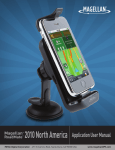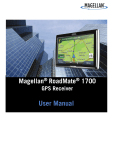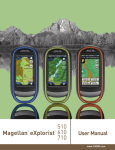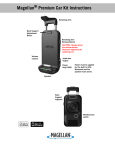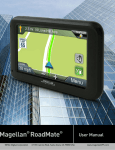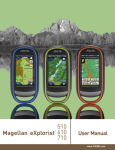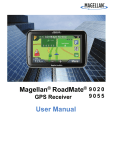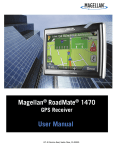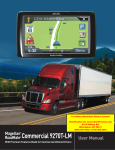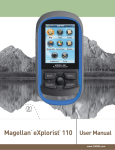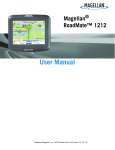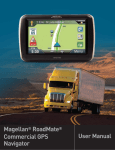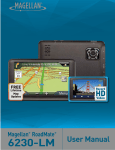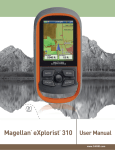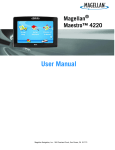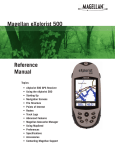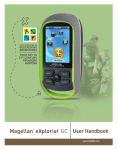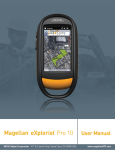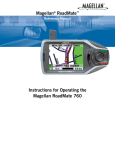Download Magelan GPS Systems User Manual
Transcript
Magellan RoadMate ® ® User Manual www.CARiD.com Magellan RoadMate GPS Receiver The Magellan® RoadMate® receiver is a vehicle navigation product that utilizes GPS signals from satellites to calculate your precise location and compute navigational information that can be used to guide you to your destination. Knowing its position and movement, it can then overlay this information on detailed maps to provide a visual representation of your location. With the Magellan RoadMate receiver you can: • Save searches and addresses under the OneTouch™ menu for fast, convenient access to favorite destinations and searches. • Store your home address and quickly get routing details to your home. • Enter and save addresses in your address book that can be accessed at any time and get routing information to that address. • Route to an address that you enter using the QuickSpell™ and Smart City search for easy, errorless address entry. • Route to any point of interest (POI) that has been preloaded into your Magellan RoadMate receiver. • Create a route with multiple destinations. Handy for business people who need routing information to many destinations. • Access the AAA TourBook® providing ratings and descriptions on AAA-approved places to stay, play, dine, and save. • Access AAA Member Roadside Assistance™ information from the OneTouch menu. • View POIs that are near exits ahead of you on the highway. The Highway Exit POIs function provides you with a list of gas stations, restaurants, hotels and auto repair shops located nearby exits you are approaching while travelling on the interstate. • Customize your Magellan RoadMate receiver to meet your needs using the Settings menu. The user interface for the Magellan RoadMate receiver is easy and simple to follow once you understand the basics. You may never need to refer to this manual, but if you do, we have tried to present it in a form that makes it easy for you to access the function you are trying to use and follow the steps provided. The Magellan RoadMate receiver has a built-in battery so, in most cases, you will be able to follow these instructions while reading them on your computer screen without plugging the Magellan RoadMate receiver to the AC power using an optional AC power adapter. Note that a fully charged Magellan RoadMate only has about 2 hours of battery life. You should note that while indoors you may not get strong enough satellite signals to compute your location, so your location information may not be updated. However, the power of the GPS chipset installed in the Magellan RoadMate receiver will pick up satellite signals in some very demanding locations. You may find that the Magellan RoadMate receiver is computing a position, even indoors. Even with the improved GPS chipset, the receiver may not be able to always compute a fix indoors. This is especially important to note if you are in a garage or other overhanging structure. If you find you are not getting strong enough satellite signals while in a garage or other structure, move to a location where there is a clear view of the sky and you should immediately see an improvement in signal strength. The Magellan RoadMate receiver includes Voice Alerts (both prerecorded and Text-toSpeech) for driving instructions. This document is set up to be printed on 8.5” x 11” paper should you desire a printed version for your reference. Magellan RoadMate A B C (A) Power Switch (B) micro SD card slot. The microSD card is available for accessing optional map regions. Check the Magellan store at www.magellangps.com for additional map regions that may be available for your receiver. (C) USB Connection. Power input from vehicle power adapter cable or optional AC power adapter. Also used for connecting your receiver to a personal computer for updating maps and software using the Magellan Content Manager application. Reset The reset button is located on the back of the receiver in the lower right corner. If you have problems with your receiver or in the unlikely event that it locks up, use a paperclip and gently insert it into the reset hole to press the reset button with the receiver turned on. The receiver should restart with the factory defaults loaded. Reset Fundamentals Powering on the Magellan RoadMate receiver The Power On/Off switch is located on the top of the Magellan RoadMate receiver. Turning the Magellan RoadMate receiver On 1. Press the power switch. 2. After the initial splash screen the Warnings screen is displayed. Read and . tap Turning the Magellan RoadMate receiver Off Viewing the Battery Level Indicator 1. While viewing the Map screen, tap on the Menu button in the right corner. 2. The battery level indicator is located in the upper right corner of the Main Menu, just below the satellite signal indicator. Green bars indicate battery level. Speaker Volume Changing the Volume from the Map Screen 1. Tap the speaker icon . Additional controls appear. 1. Press the power switch. The receiver will automatically power off in 15 seconds. [Cancel] cancels the power off sequence and returns to last viewed screen. [Power Down Now] turns the receiver off immediately, bypassing the 15 second delay. Note: Anytime the power cable is disconnected from the receiver or if power is turned off at the 12v power receptacle, the receiver will begin the power off sequence. Battery Levels The Magellan RoadMate receiver has an internal battery that is charging whenever the receiver is connected to external power. 2. Tap the speaker button to mute the volume, or tap the ‘+’ or ‘-’ buttons to raise or lower the volume. 3. Tap . Changing the Volume from Settings 1. Access the Main Menu. 2. Tap the Settings icon . 3. Tap Sound. 4. Tap inside the Master volume adjust bar to change the volume level of the Magellan RoadMate receiver. 5. Tap to save and exit. Setting Button Sounds On or Off 1. Access the Main Menu. Note: The battery can only be serviced by authorized Magellan repair facilities. 2. Tap the Settings icon . 3. Tap Sound. 4. Tap the check box for Button Sounds. Check to have button sounds played, unchecked to turn them off. Setting Smart Volume On or Off Main Menu The Main Menu screen is the center for all available functions of the Magellan RoadMate receiver. The Main Menu contains large, easy to access icons for all the major functions. Smart Volume is a feature of the receiver that changes the volume automatically as your speed changes, compensating for road noise. 1. Access the Main Menu. 2. Tap the Settings icon . 3. Tap Sound. 4. Tap the check box for Smart Volume. When checked, Smart Volume is on. Brightness Accessing the Brightness Control 1. Access the Main Menu. 2. Tap the Settings icon . Accessing the Main Menu 1. From the Map screen tap Menu. Functions Available from the Main Menu Address 3. Tap System. 4. Tap Brightness. Points of Interest Previous Intersection 5. Tap inside the brightness adjust bar to set the desired brightness. Note: On the Brightness Setting screen there is a “Dim on Battery Power” option. When checked, the Magellan RoadMate receiver will reduce the brightness when operating exclusively on battery power and you have not used the touch screen for a few seconds. This prolongs the battery life between charges. City Center Current Location Back Enter an address as a destination for you route. Select a Point of Interest (POI) from the list of preloaded locations as a destination. List of the most resent destinations that you have gone to before allowing you to quickly select one to route to again. Create a route to the intersection of two streets. Create a route to the geographical center of a city. Displays information about your position including the street name, names of streets forward and behind you as well as the Lat/ Long information for your position. Access the Map screen. Address Book Settings Satellite Status Battery Level Access the Address Book where you can save addresses and destinations to have available when needed. Displays the Settings menu. This menu can be used to access functions used to customize the Magellan RoadMate receiver to your personal needs. Graphic display of the strength of satellite signals being received. Graphic display of the current battery level. Symbols Displays available symbols. Previous Previous destination list (Enter City only) When entering a city, the previous destinations list displays a list of cities previously entered. Tap on a city from the displayed list to accept that city. (Enter City only) Displays a numeric keypad to quickly enter a city when the zip code is known. (Enter City only) While entering a city, press the List button to bring up a list of cities beginning with the characters you have entered. (Entering City) Accepts the suggested city that is displayed in the data field. (Entering street) Brings up a list of streets beginning with the characters entered. Zip Code List Keypad The keypad is the most common method for entering data into the Magellan RoadMate receiver. Understanding the keypad while entering an address is an important part of using your Magellan RoadMate receiver. Accept Selecting From List When a list of items found in the database are displayed, use the arrows on the right to move the list up and down and tap on the desired item in the list to continue. Selecting QWERTY or ABC Keyboard 1. Access the Main Menu. Keypad Overview Backspace Shift Space Numeric Moves the cursor one position backwards, deletes the preceding character. Shifts between uppercase and lowercase characters. Inserts a space at the cursor position. Displays a numeric keypad. 2. Tap the Settings icon . 3. Tap Keyboard. 4. Select QWERTY or ABC. Notes on Entering Data If you are having trouble getting the results you expected, here are a few useful tips. • Check for apostrophes and hyphens. If you do not see the POI or street name you are looking for in the list, check to see if the name has an apostrophe or hyphen. • The more characters you enter, the smaller the list of possible options is from which to choose. • When entering a street or city name it is not necessary to use accented letters. You can enter city and streets names using only standard characters. QuickSpell Another feature the Magellan RoadMate receiver uses to make entering cities and streets easier is a feature known as QuickSpell. As letters are entered for a city or street the Quickspell feature checks the database for cities or streets that begin with the letters entered. Any letters that could not be used to spell a city or street name are greyed out. This provides quick and error-free city and street name entry. If the city is correct, tap the continue. button to button can be tapped to display The the list of cities that begin with the letters entered. Smart City Search The Magellan RoadMate receiver utilizes a feature known as “Smart City Search”. Smart City Search attempts to predict the city you are looking for. This prediction is based upon two factors; your position and cities you’ve gone to before. Whenever entering or searching on an address the first screen displayed is the Enter City Name keyboard. As letters are entered, Quickspell checks the database for cities beginning with the letters entered. Keys that don’t spell a city in the database are greyed out and Smart City Search displays a suggested city in the text field. Quickspell and Smart City Search makes entering an address quick and easy with little chance for errors. Map Screen The most commonly used screen is the Map screen. Whether you are following a route or just traveling around a city, the chances are that the Map screen will be displayed. The Map screen can be displayed in two unique modes: normal and routing. In normal mode, your position is shown on the map along with the time. As you travel, your position will be updated, giving you a clear view of your position and surrounding streets. H G F F E B A B G A In routing mode additional information is displayed providing detailed information about the route you have selected. D C (A) Current location. (B) Information display. Displays speed, time of day, elevation, compass direction. Tap on the information field to change. (C) Zoom Out/In. (D) Access Main Menu. (E) Access Highway POIs (displayed only while on a highway). (F) Access volume controls. (G) Access OneTouch Menu. OneTouch Menu gives you instant access to your saved search criteria and favorite destinations. C E D (A) Turn instructions for next maneuver. Tap to display the maneuver list (available only when routing). Distance and road name for the next maneuver. Tap to repeat last voice instruction. (B) Speed limit (C) Information display. Displays speed, time of day, elevation, compass direction. While routing it also can also display distance to destination, estimated time of arrival (ETA), and time remaining. Tap on the information field to change. (D) Zoom in and zoom out controls to change the map scale. (E) Access Main Menu. (F) Access the list of nearest Highway Exit POIs (available only when driving on a highway/freeway/interstate). (H) Access volume controls. (G) Access OneTouch Menu. OneTouch Menu gives you instant access to your saved search criteria and favorite destinations. Setting the Map Options How your map is displayed can be customized in Settings to your preferences. 1. From the Map screen, tap the MENU button. Panning on the Map 1. While viewing the Map screen, slide your finger or a stylus across the map. 2. The map screen changes to Pan mode. 2. Tap the Settings Icon. 3. Tap Map button. 4. Use the Map Options screen to customize what and how your map is to be displayed. 3. When finished, tap and the map returns to your current position. Routing to a Panned Position 1. Pan the map until the location you wish to route to is displayed. Setting the Map Modes (2D or 3D) The map is normally displayed in 3D mode (perspective view) but you can set the map to 2D mode (top down view) if so desired. 2. Tap on the map at the point you want to go to. A red push pin will be displayed along with information about the point chosen at the top of the screen. 1. From the Map screen, tap anywhere on the map. Additional controls appear. 2. Tap 2D to switch the map to 2D mode from 3D mode, or tap 3D to switch the map to 3D mode from 2D mode. 3. Tap . Setting Zoom Levels Select the zoom level that best suits your needs. Note that zoom levels are limited in 3D mode. As you zoom out in 3D, the display will switch to 2D at higher zoom levels. 1. Tap the ‘+’ or ‘-’ zoom level buttons at the bottom of the Map screen to set the desired zoom level. 3. Tap the GO button in the top left corner. 4. If an active route already exists, you will need to define what to do with this new route point: Replace Destination: the next destination is cleared and replaced with the one selected from the Pan screen. Go There Now: the selected location is inserted in the route as an intermediate destination before the next destination. Add To Trip: the selected destination is added to the end of the current trip. 5. Tap the large GO button on the right to begin navigating and return to the Map screen. Note: if the panned position does not match an existing street address (i.e. the destination is not along a road or street that is stored in the map database), the guidance will stop on the road that is closest to your destination. A dashed line to your final destination will then be displayed on the map. Current Location Screen The Current Location screen displays the approximate address of your current position, the next and previous intersections, your latitude, longitude, heading and elevation. (optional) Tap List Categories to select a category for this address. New categories can be added from the Select Category from List screen by tapping the +Add button. 5. When the details for this address are acceptable, tap . 6. If you have selected to save this point to the OneTouch menu, you need to select a button for the entry. Maneuver List (Itinerary) This screen is accessed from the Map screen and is available only when routing. Each line in the Maneuver List provides details about the maneuvers in the order that they are to be made, with the next maneuver at the top. Accessing the Maneuver List 1. When actively on a route, tap the maneuver icon in the top left corner of the Map screen. Accessing the Current Location Screen 1. From the Map screen tap on the current position icon. Saving Your Current Location to Your Address Book 1. From the Map screen tap on the current position icon . 2. Tap Save. 3. Edit information: (optional) If you want to save this location to the OneTouch menu as well as the address book, check the Add to OneTouch box. 4. Tap the Name field and use the keypad to enter a name for the Address Book entry. Avoiding a Maneuver This is used to modify the route to possibly avoid routing on a particular street. 1. Access the Maneuver List. 2. Tap the Avoid icon you want to avoid. for the maneuver 3. Tap Yes to confirm. 4. The Magellan RoadMate receiver recalculates the route and the Map screen is displayed. Changing Route Options The options for how a route is computed can be changed to Fastest Time, Shortest Distance, Mostly Freeways, Least Use of Freeways. 1. Access the Maneuver List. 2. Tap on Route Options. 3. The four types of routes are displayed with the computed time. A indicates that the route will use a toll road. 4. Tap on the desired route option. 5. The GO screen is displayed. Tap GO to begin routing. Volume The volume can be adjusted or muted from the Map screen. (The volume can also be adjusted from Settings > Sound.) Changing the Volume from the Map Screen 1. Tap the speaker icon . Additional controls appear. 2. Tap on the Speaker button to mute the volume, or tap the ‘+’ or ‘-’ icons to change the volume levels. 3. Tap . When muted the speaker icon on the Map screen will appear with a red diagonal line through it. Tap on the speaker icon again ut unmute the volume. OneTouch Menu The OneTouch™ menu provides quick access to your home address, emergency services, gas stations and addresses or searches you have stored to the OneTouch menu. Accessing the OneTouch Menu 1. From the Map screen, tap the OneTouch icon in the upper right corner. To use your current location for Home, just press the Use My Current Location button. Note: If you need to edit or delete the Home address you selected here you can do this by going to the Address Book (found in the Main menu) and edit the entry labeled “Home”. Saving an Address to a OneTouch Icon 1. Tap the Edit button in the top right corner of the Map screen. The OneTouch menu appears. 2. Tap one of the Assign icons. 3. Tap Location. 4. Using the keypad, enter the address (city, street and number) for the OneTouch icon. 5. When the address is complete you are prompted to enter a name for the button. The Home Button Tap the Home icon. If you have a Home Address saved, the receiver will begin giving you navigation information to arrive at your home. If you do not have a Home Address saved you will be prompted to enter one. 6. Using the keypad, enter a name for the button and tap . 7. Verify that the address has been added by going to the Map screen and accessing the OneTouch menu. Changing the Address or Search of a OneTouch Icon 1. Tap the Edit button in the top right corner of the Map screen. The OneTouch menu appears. 2. Tap the Edit button. 3. Tap on the OneTouch button you want to edit. 4. Tap on the Re-assign button. 5. Tap Yes to confirm. If you select Yes, you will need to enter your home address using the Enter Address keyboard. 6. Follow the instructions for assigning a OneTouch button. Saving a POI Search Criteria to a OneTouch Icon Besides frequently visited destinations, you can also save POI search criteria to a OneTouch button. For example you may frequently search for coffee shops near your location or gas stations along your route. You can save these searches for later use. 1. Tap the OneTouch button in the top right corner of the Map screen. 2. Tap one of the Assign buttons. 3. Tap Search. 4. Tap one of the POI categories in the list. Setting a Route to a OneTouch Icon With the OneTouch menu set up you can now go to a saved address or search. 1. Tap the OneTouch button in the top right corner of the Map screen. 2. Tap one of the assigned OneTouch buttons. 3. If the assigned button is for a search, the list of POIs is displayed. Tap on the desired POI. The “Preview” icon at the bottom of the display allows you to step through the available POIs while viewing their location on the map. 4. The “Near...” button allows you to select how the list is sorted (nearest your current position, nearest a city you define or near an address you enter). 5. Whether the destination was chosen from a list of POIs or by an address, the GO screen is displayed Tap on the Go button to begin the route. 5. If the next screen contains a list of subcategories, tap one of the POI subcategories in the list to further narrow the search, or tap “All Subcategories” to select all the subcategories or continue defining your search criteria. 6. Using the keypad, enter a name for the . button and tap Selecting a Destination Creating a Destination to an Address 3. Enter Street name: When creating an address, the first step is to enter the city. The city can be specified by entering the name of the city, entering the ZIP code for the city or by selecting a previously used city. 1. From the Main Menu tap the Address icon. 2. Enter City: With the city selected, the keyboard will be displayed prompting you for the street name. You have three ways to do this: To select the city from the list of previous cities, tap the Previous button. To enter a new city: use the keyboard to enter the first few characters of any significant word in the city name. If the city you are entering appears in the top field you can tap on the city name or . Use the keyboard to enter the street name. It is not necessary to enter accented characters. Enter the first few characters of any significant word in the street name and tap the or continue entering characters until the list of streets is displayed. 4. Tap on the street name from the list. 5. Enter Street number: At any time you can tap on the List button to bring up a list of cities that begin with the characters you entered. Tap to select the city from the list. To enter a ZIP code: if needed, tap the Zip Code button to switch to the numeric keyboard. Enter the ZIP code. Tap to bring up a list of cities with the zip code entered. Use the keyboard to enter the street number for the address. The range of acceptable street numbers is displayed before you start typing. Tap the when the street number is complete. 6. The GO screen appears with the address of the selected location, the estimated time of arrival (ETA), the distance to travel, and the routing method (e.g. Fastest Time). Intersections Creating a Destination to an Intersection When the street number is not known, an intersecting street can pinpoint the location. 1. From the Main Menu, tap the Intersection icon. 2. Enter City: You have three ways to do this: To select the city from the list of previous cities, tap the Previous button. (optional) Tap Options if you want to change the routing method. (optional) Tap on to preview the route. 7. Tap the large GO button on the right to return to the Map screen and begin routing. Tip: If you know that you will use a destination later, before tapping the orange button you can tap Save to save it in your Address Book or in the OneTouch menu. Tips on Entering Addresses Quickly • When you are entering the name of a city or a street, Magellan software only displays those characters that appear in possible search results. The other characters are grayed out. • When entering city names or street names, tap the List button after a couple of letters; Magellan software lists the items that contain the specified characters. • You can also search by ZIP codes. This narrows the number of matching cities to normally less then four. To enter a new city: use the keyboard to enter the first few characters of any significant word in the city name. If the city you are entering appears in the top . field you can tap on the city name or At any time you can tap on the List button to bring up a list of cities that begin with the characters you entered. Tap to select the city from the list. To enter a ZIP code: if needed, tap the Zip Code button to switch to the numeric keyboard. Enter the ZIP code. Tap to bring up a list of cities with the zip code entered. 3. Enter Street name: With the city selected, the keyboard will be displayed prompting you for the street name. Use the keyboard to enter the street name. It is not necessary to enter accented characters. Enter the first few characters of any significant word in the street name and tap the or continue entering characters until the list of streets is displayed. Tap on the street name from the list. 4. Enter the second street: Enter the name of the second street as you did the first street. 5. A screen appears with the address of the selected location, the estimated time of arrival (ETA), the distance to travel, and the routing method (e.g. Fastest Time). (optional) Tap Options if you want to change the routing method. 6. Tap the large GO button on the right to return to the Map screen and begin routing. City Centers Creating a Destination to a City Center City Center allows you to select any city on the map as your destination. This option is particularly useful when you want to go to a city without having any specific address to select. (A route to a city center uses the geographical center of the city as the destination point.) 1. From the Main Menu, tap the City Center icon. 2. Enter City: To select the city from the list of previous cities, tap the Previous button. To enter a new city: use the keyboard to enter the first few characters of any significant word in the city name. If the city you are entering appears in the top . field you can tap on the city name or At any time you can tap on the List button to bring up a list of cities that begin with the characters you entered. Tap to select the city from the list. To enter a ZIP code: if needed, tap the Zip Code button to switch to the numeric keyboard. Enter the ZIP code. Tap to bring up a list of cities with the zip code entered. 3. A screen appears with the address of the selected location, the estimated time of arrival (ETA), the distance to travel, and the routing method (e.g. Fastest Time). (optional) Tap Options if you want to change the routing method. 4. Tap the large GO button on the right to return to the Map screen and start navigating. Previous Destinations Routing to a Previous Destination 1. From the Main Menu, tap the Previous icon. 2. Select the destination from the list of previous destinations. 3. A screen appears with the address of the selected location, the estimated time of arrival (ETA), the distance to travel, and the routing method (e.g. Fastest). (optional) Tap Options if you want to change the routing method. 4. Tap the large GO button on the right to return to the Map screen and start navigating. Clearing the list of Previous Destinations 1. Access the list of Previous Destinations as described above. 2. Tap Delete All to clear the list. 3. To confirm the deletion, tap Yes. Address Book Saving a Destination to Your Address Book Whenever you create a destination you can save the destination to your address book before beginning the route. 1. On the Go screen, tap Save. 2. The Edit Information screen is displayed. If you want to save this location to the OneTouch menu, select Add to OneTouch. Edit information: Tap the Name field and use the keyboard to enter a name for the address book entry. (optional) Tap <Work, Cell or Home phone> to specify a phone number for the address book entry. (optional) Tap List Categories to bring up a list of categories you have created for your address book. If the category you want isn’t there, you can create one by tapping the “+ Add” button at the bottom of the screen. 3. When the details for this address are . acceptable, tap 4. If you have selected to save this to the OneTouch menu, you be asked to select a the OneTouch button you want it assigned too. Accessing an Address in Your Address Book 1. From the Main Menu, tap the Address Book icon. 2. To easily find the desired address you can tap the top left corner of the screen and narrow the list by the first letter of the address book entries. Routing to an Address in Your Address Book 1. Access the address record from your address book as described above. 2. Tap the GO icon of the desired address book entry. A screen appears with the address of the selected location, the estimated time of arrival (ETA), the distance to travel, and the routing method (e.g. Fast). 3. (optional) Tap Options if you want to change the routing method. 4. Tap the large GO button on the right to return to the Map screen and start navigating. Points of Interest (POI) The Magellan RoadMate receiver has preloaded POIs that can be used as a destination for a route. Selecting a restaurant or finding a gas station nearby is at your fingertips. 4. POIs near your current position are displayed. You can tap “Near...” for different search criteria (Near Current Position, Near City, or Near Address). Creating a Route to a POI by Category POIs are categorized into unique categories from gas stations to tourist attractions. Most, but not all categories are further organized into subcategories. Restaurants have, for example, several subcategories that provide a way to search for restaurants serving Chinese food, fast food, or other favorites. 1. From the Main Menu, tap the Points of Interest icon. 2. Tap one of the POI categories in the list. If you select Near City or Near Address you will need to enter the city or address information. 5. Select the POI desired from the list of POIs. 6. The ‘Go’ screen appears with the address of the selected location, the estimated time of arrival (ETA), the distance to travel, and the routing method (e.g. Fastest Time). 3. If the next screen contains a list of subcategories, tap one of the POI subcategories in the list to further narrow the search. (optional) Tap Options if you want to change the routing method. You can select from Fastest Time, Shortest Distance, Mostly Freeways or Least Use of Freeways. 7. Tap the large Go button on the right to return to the Map screen and begin navigating to the POI selected. Creating a Route to a POI by Name 1. From the Main Menu, tap the Points of Interest icon. 2. Tap the Search By Name button. 3. Spell the name of the POI to be used as the destination. You don’t need to enter the full name, but the more characters you enter, the easier it will be to find the . exact POI you are searching for. Tap 4. POIs near your current position are displayed. You can tap “Near” for different search criteria (Near Current Position, Near City, or Near Address). If you select Near City or Near Address you will need to enter the city or address information. 3. Small symbols represent the following service POIs near the exits: Restaurants Gas Stations 5. Select the POI desired from the list of POIs. Car Repair 6. The ‘Go’ screen appears with the address of the selected location, the estimated time of arrival (ETA), the distance to travel, and the routing method (e.g. Fast). Accommodations (optional) Tap Options if you want to change the routing method. 7. Tap the large Go button on the right to return to the Map screen and start navigating. Creating a Route to a Highway Exit POI The Highway Exit POIs function provides a way of accessing commonly used POIs that are near an exit you are approaching while travelling on a highway. Highway Exit POIs include restaurants, gas stations, car repair facilities and hotels. Freeway Exit POIs can be accessed while on a route or just driving, as long as you are on a freeway. 1. From the Map screen, tap the Highway Exit POIs button when it appears. 2. The list of the next freeway exits and their distance from your current position appear. 4. Tap any of the symbols to get a list of related POIs near the exit. 5. Select one POI from the list, and tap . 6. The ‘Go’ screen appears with the address of the selected POI, the estimated time of arrival (ETA), the distance to travel, and the routing method. (optional) Tap Options if you to change the routing method. 7. Tap the Go button on the right to return to the Map screen and begin routing to the POI selected. Traveling on a Route Map Screen When a route has been calculated, it will be displayed on the Map screen in green with small arrows indicating the direction of travel. The top of the screen displays the name of the street that comes next in your Turn List together with its distance. If you are not in the city in which the next street is, the name of the city is displayed instead. 5. The Magellan RoadMate receiver recalculates the route and the Map screen returns. Types of Routes There are a wide variety of methods you can use to create a route. Each method is discussed in the chapter which is associated with it. Routing Method As the route progresses, voice alerts will be used to prompt you of upcoming maneuvers. Maneuver List The Maneuver List displays all of the maneuvers needed to be made to complete the route and arrive at the destination. To view the Maneuver List, tap on the maneuver icon in the top left corner of the Map screen. Regardless of which route type has been created, the Magellan RoadMate needs to know how the route is to be calculated. Routes can be calculated by the following methods: Fastest Time (Fast): the fastest possible route provided the vehicle is able to travel at or near the speed limit. Shortest Distance (Short): the shortest possible route. Accessing the Maneuver List When actively following a route, tap the maneuver icon in the top left corner of the Map screen. Excluding a Maneuver 1. This is used to modify the route to possibly avoid routing on a particular street. 2. Access the Maneuver List. 3. Tap the Avoid icon for the maneuver you want to avoid. 4. Tap Yes to confirm. Most Use of Freeway: creates a route that uses freeways whenever possible. Least Use of Freeway: creates a route that avoids use of freeways. When a destination is selected, the Magellan RoadMate offers the route with the default selected routing method first. Changing the Routing Method To change the routing method, tap Options when the ‘Go’ screen is displayed. The Magellan RoadMate calculates the route with different methods. 1. Tap on the icon to view the maneuver list for the route method desired. 2. Tap the desired routing method in the list, and the previous screen returns with the new calculation. Detouring off a Route 1. From the Map screen, tap Menu. 2. Tap the Detour icon. To Change the Default Routing Method 1. From the Main Menu, tap the Settings icon. 2. Tap Navigation Preferences. 3. Use the Route Method drop-down menu to select the default routing method desired. Special Routing Functions Cancelling a Route 1. From the Map screen, tap Menu. 2. On the Main Menu, tap the cancel route icon. 3. Different detours are calculated using the same routing method that was used to create the route. The list of alternate routes is displayed. (optional) You can check the Maneuver List of an alternate route if you tap the button on the right. 4. Tap the desired alternate route. 3. Confirm that you want to cancel the route. Tap Yes. OR 4. Tap the OneTouch icon from the Map screen to display the OneTouch menu. 5. Tap the cancel route icon. 6. Confirm that you want to cancel the route. Tap Yes. Settings With user Settings you can customize the Magellan RoadMate receiver to better suit your personal needs and preferences. Note: Tapping the Back arrow Tap from any of the Setting screens saves your changes. Accessing System Settings From the Main Menu screen, tap the Settings icon. 3. Tap Night Mode to select Automatic for the timed adjustment, on always or off always. Setting Heading Up or North Up in 2D Mode 1. From the Main Menu screen, tap the Settings icon. 2. Tap Map. 3. Tap 3D, 2D Heading Up or 2D North Up to toggle between settings. Assigning Visible POIs To avoid cluttering of the map, the POI icons that are displayed on the map can be turned on or off. 1. From the Main Menu screen, tap Settings. 2. Tap Map. 3. Tap POI Visibility. Map Options 4. Use the POI Selection screen to check those POIs you want shown and uncheck those you want hidden. Setting Auto Zoom on Turns You can set the map to automatically zoom in to the lowest level when coming up to a turn. 1. From the Main Menu screen, tap the Settings icon. 2. Tap Map. 3. Checking Auto Zoom on Turns enables this function. Setting Auto Night Map Display Normally the map is displayed in vivid colors for daytime use and with dark tints for night use. You can select whether to always use daytime colors, night color or let the Magellan RoadMate receiver switch between them automatically a few minutes before sunrise and a few minutes after sunset. 1. From the Main Menu screen, tap the Settings icon. 2. Tap Map. Setting Highway Lane Assist When Highway Lane Assist is checked, the map will display highway signs as you approach a highway interchange giving you visual indication of which lane you want to be in. 1. From the Main Menu screen, tap the Settings icon. 2. Tap Map. 3. Checking Highway Lane Assist enables this function. Sound Setting Volume from Settings 1. From the Main Menu screen, tap the Settings icon. 2. Tap Sound. 3. Tap inside the volume slider bar to set the desired volume level. Turning Button Sounds On/Off 1. From the Main Menu screen, tap the Settings icon. 2. Tap Sound. 3. Unchecking Button Sounds will turn off the audible indication that a button is tapped. Turning Smart Volume On/Off Smart Volume adjusts the sound levels based on vehicle speed which normally increases road noise making the speaker harder to hear. 1. From the Main Menu screen, tap the Settings icon. 2. Tap Sound. 3. Unchecking Smart Volume turns Smart Volume off. Navigation Setting The Turn Warning Alert Sounds 1. From the Main Menu screen, tap the Settings icon. 2. Tap Navigation Preferences. 3. Use the drop-down menu to select the default sound you want played when alerting you to a turn. Enabling Landmark Guidance Landmark Guidance uses common landmarks when available to help you identify streets requiring a maneuver. 1. From the Main Menu screen, tap the Settings icon. 2. Tap Navigation Preferences. 3. Checking Enable Landmark Guidance turns Landmark Guidance on. Enabling Spoken Street Names 1. From the Main Menu screen, tap the Settings icon. 2. Tap Navigation Preferences. 3. Checking Enable Spoken Street Names allows street names to be spoken while giving guidance. Enabling U Turn Guidance 1. From the Main Menu screen, tap the Settings icon. 2. Tap Navigation Preferences. 3. Checking Enable U Turns will allow the receiver to use U turns when necessary to compute your route. Avoiding Toll Roads 1. From the Main Menu screen, tap the Settings icon. 2. Tap Navigation Preferences. Setting The Default Route Method 1. From the Main Menu screen, tap the Settings icon. 2. Tap Navigation Preferences. 3. Use the drop-down menu to select the default routing method. 3. Checking Avoid Toll Roads tells the receiver to avoid toll roads whenever possible. Brightness Phantom Alerts Setting Brightness 1. Access the System Settings menu (above). 2. Tap Brightness. 3. Tap in the brightness slider to set the brightness of the display for either day or night use. 4. Tap the back arrow . 5. The Dim on Battery Power option will prolong battery life by dimming the display while using internal battery power. Check to turn this option on. Languages Setting Languages 1. Access the System Settings menu (above). 2. Tap Languages. Phantom Alerts provide information on information that might affect the route you are on. There are Standard Alerts that are included in the Magellan Roadmate and Premium Alerts that are greyed out until they have been purchased from the Magellan Store. Setting Phantom Alert Options 3. Tap on the desired language. 1. From the Main Menu screen, tap the Settings icon. 4. Confirm the change. 2. Tap Phantom Alerts. 5. Tap the back arrow. 3. Tap on the alert to be set. Speed Warnings Setting Speed Warning Options 1. From the Main Menu screen, tap the Settings icon. 2. Tap Speed Warning. 3. Set Audible Warning on or off. 4. Set Visible Warning on or off. 5. The Visible checkbox determines if the speed limit icon is displayed on the screen. 6. Set the number of miles above the speed limit you want the warnings to be alerted or highways and other roads. 4. There are three options for phantom alerts that can be turned on or off; audio alert, visual alert, and show on map. 5. When an option is checked it is turned on. 6. Tap the back arrow. Time Zone Selecting the Time Zone 1. Access the System Settings menu (above). 2. Tap Time Zone. 3. Check Auto Time Zone or select your time zone from one of the cities in the list. 4. Tap the back arrow. Time Format Setting the Time Format 1. Access the System Settings menu (above). 2. Tap Time Format. 3. Tap on 24 Hours or 12 hours with am/ pm. 4. Tap the back arrow. Keyboard Setting the Keyboard Layout. 1. From the Main Menu screen, tap the Settings icon. 2. Tap Keyboard. 3. Select QWERTY (default) or ABC keyboard layouts. Units of Measure Selecting Units of Measure 1. Access the System Settings menu (above). 2. Tap Units. 1. From the Main Menu screen, tap the Settings icon. 2. Tap GPS Options. 3. Tap Set GPS Position. 4. Enter an address as you were selecting a destination. Viewing the GPS Status 1. From the Main Menu screen, tap the Settings icon. 2. Tap GPS. 3. Tap Status. 4. (Optionally you can tap on the satellite signal indicator in the upper right corner of the OneTouch screen to access the GPS Status screen.) Auto Power Off Setting Auto Power Off Auto power is the duration of time that the Magellan RoadMate receiver remains idle before turning off automatically. 3. Tap on the desired unit of measure. 1. Access the System Settings menu (above). 4. Tap the back arrow. 2. Tap Auto-Off. Regions 1. From the Main Menu screen, tap the Settings icon. 2. Tap Region. 3. Select an available map that is installed in your receiver. GPS Setting the GPS Position 3. Tap on the desired duration. 4. Tap the back arrow. Default System Settings Restoring All Default System Settings 1. Access the System Settings menu (above). 2. Tap Restore Default. 3. Confirm that you want to proceed in restoring all the system defaults. It is useful to set a GPS position if you are not Product Information receiving satellite information quickly due to travelling over 800 km/500 mi with the Viewing Product Information Magellan RoadMate receiver turned off. Setting 1. From the Main Menu screen, tap the the GPS position will allow the Magellan Settings icon. RoadMate receiver to compute which satellites 2. Tap Product Information. are available and calculate the position more 3. (Note: Scroll down the page to view the quickly. Serial Number and Software Version.) MAGELAN GPS GPS SYSTEMS

























